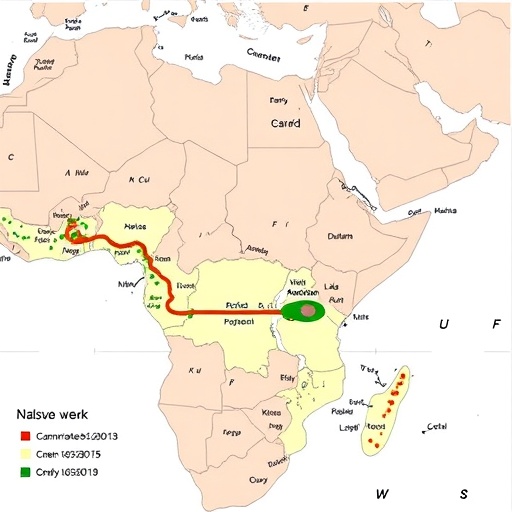Ancient foragers, particularly those in Southern Africa, have long fascinated archaeologists and researchers alike. Among these ancient peoples, the inhabitants of present-day Malawi have garnered attention due to the rich tapestry of their biogeochemical signatures. Recent studies illuminate the complex patterns of landscape use by these ancient foragers, revealing that their interactions with the environment were not merely opportunistic but rather finely tuned to their needs and the ecological contexts they inhabited. This research sheds light on how ancient human populations adapted their behaviors and strategies based on the specific biogeochemical characteristics of their environment.
The study conducted by a team of researchers provides compelling evidence that ancient foragers in Malawi engaged in targeted landscape use. This is a significant departure from the traditional view of foragers merely responding to the immediate availability of resources. Instead, the findings suggest that these early humans had a sophisticated understanding of their surroundings, allowing them to optimize their foraging strategies over time. The data gathered supports the notion that these ancient populations were not merely transient visitors within their landscapes but were, instead, active participants who shaped and were shaped by their environments.
The researchers employed multifaceted approaches to obtain their data, integrating biogeochemical analyses with archaeological investigations. By examining soil samples from various locations associated with these ancient foragers, the team was able to reconstruct past ecological conditions and resource availability. This detailed examination of soil chemistry revealed insights into the plant and animal resources that would have been available to the foragers at different periods. Such data significantly enhances our understanding of the subsistence strategies employed by ancient peoples in risky environments.
One of the most striking findings of the study was the evidence of resource management practices among the ancient foragers. The ability to identify and utilize specific plants and animals that thrived in particular ecological niches demonstrates a level of environmental awareness that goes beyond simple survival tactics. For example, certain plant assemblages indicated deliberate harvesting practices, where foragers would return to specific areas for certain resources seasonally. This highlights a nuanced understanding of plant growth cycles and nutrient availability, which is similar to later agricultural techniques.
Moreover, the research team uncovered indicators of social organization that may have influenced landscape use. The spatial distribution of specific biogeochemical markers suggests that social networks among foragers could have been sophisticated and extended, enabling them to share knowledge about resource-rich areas. This lateral sharing of information would have been crucial for managing resources effectively and ensuring the survival of the group in a landscape subject to fluctuations due to climate change or other factors.
The implications of these findings extend beyond Malawi and into the broader context of human evolution and adaptation. The ability to purposefully exploit certain landscapes would have conferred significant advantages, potentially influencing migration patterns and settlement behaviors. Understanding how early foragers interacted with their environments can provide insights into how current and future human populations might address similar challenges related to resource management and sustainability.
Furthermore, the biogeochemical evidence underscores the importance of interdisciplinary studies that integrate ecology, archaeology, and anthropology to fully grasp the complexities of human-environment interactions throughout history. The ancient foragers of Malawi serve as a compelling case study in this regard, indicating that their practices could inform modern strategies for living in harmony with our environments.
As climate change continues to challenge contemporary societies, reflecting on how ancient peoples navigated their own environmental hurdles can offer valuable lessons. The adaptability and resourcefulness exhibited by these foragers illustrate the importance of resilience and strategic thinking in the face of ecological uncertainty. They serve as a reminder of the profound connections that exist between humans and their landscapes.
Researchers are optimistic that the methodologies employed in this study can be applied to other archaeological contexts, potentially illuminating how different populations across the globe adapted to their specific environments. As more regions are studied with similar biogeochemical techniques, a clearer picture will emerge of the diverse adaptations and innovations that characterized ancient human societies.
The findings have, therefore, opened new avenues for exploration and discussion within the academic community and among those interested in human history and its sustainability. Engaging with the past can provide us with tools to shape a more resilient human future, fostering a deeper appreciation for the delicate interplay between humans and their ecosystems.
As we continue to seek insights from ancient practices, it is crucial to recognize the profound depth of knowledge present in traditional ecological practices. Modern society often underestimates the wisdom rooted in these ancient connections to the land, which continue to resonate today.
Understanding that ancient landscapes were actively managed rather than passively encountered is a key message of this research. It invites us to reconsider our relationships with our present-day ecosystems and the importance of conserving biodiversity and managing resources sustainably. The legacy of ancient foragers can, therefore, help to frame modern conservation efforts as we attempt to navigate the complexities of an ever-changing global environment.
In conclusion, the rigorous investigation of the ancient foragers of Malawi has unearthed a wealth of knowledge regarding their intricate relationships with their surroundings. This research not only enriches our understanding of historical human behaviors but also offers valuable perspectives on the sustainable management of natural resources. As we look forward, these insights may serve as a guiding light for future generations striving to balance humanity’s needs with the health of our planet.
Subject of Research: Ancient foragers in Malawi
Article Title: Biogeochemical evidence for targeted landscape use in ancient foragers of Malawi
Article References:
Bertacchi, A., Zipkin, A., Ambrose, S. et al. Biogeochemical evidence for targeted landscape use in ancient foragers of Malawi.
Commun Earth Environ 6, 818 (2025). https://doi.org/10.1038/s43247-025-02795-z
Image Credits: AI Generated
DOI: 10.1038/s43247-025-02795-z
Keywords: Ancient foragers, Malawi, biogeochemical evidence, landscape use, resource management.




